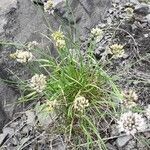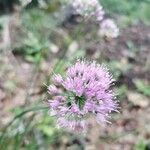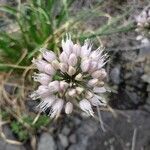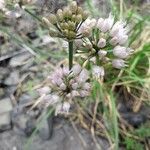Bulb solitary or paired, ovate-cylindric or conical, 1--2 cm in diam., attached to a horizontal or oblique rhizome, sometimes developed above ground; outer tunic usually blackish gray or black, scarious, entire or slightly splitting. Leaves spirally arranged, never distichous, broadly linear, sometimes slightly falcate, shorter than scape, 7--10(--12) mm wide, flat, thick, smooth or minutely scabrous, apex obtuse. Scape (25--)30--60 cm, 2-angled or narrowly 2-winged, covered with leaf sheaths only at base. Spathe 2-valved, persistent, apex acuminate. Umbel hemispheric to globose, many flowered. Pedicels equal, 2--3 × as long as perianth, a few bracteolate. Perianth pink to pale red, later becoming whitish; segments subovate, 4--6(--7) × 2--2.5 mm, apex obtuse, sometimes minutely denticulate; outer ones boat-shaped. Filaments subequal, to 1.5 × as long as perianth segments, connate at base and adnate to perianth segments; outer ones subulate; inner ones narrowly triangular. Ovary globose, without concave nectaries. Style long exserted. Fl. Jul--Aug. 2 n = 16*, 32*, (40), 48.
More
An onion family plant. It is a bulb plant. It grows 30-50 cm high and spreads 20-60 cm wide. There are one or two bulbs. They are oval or cone shaped. They are 1-2 cm across. They are attached to a rhizome or underground stem. The outer covering is usually blackish. The leaves are arranged in spirals. They are narrow and shorter than the scape. They are 7-10 mm wide and flat and thick. The scape is 30-60 cm long. It is 2 angled and has 2 narrow wings. It is covered with the leaf sheaths only at the base. They flower head is half round and has many flowers.
Can be grown by divisions or seedlings. Seeds needs stratification.




